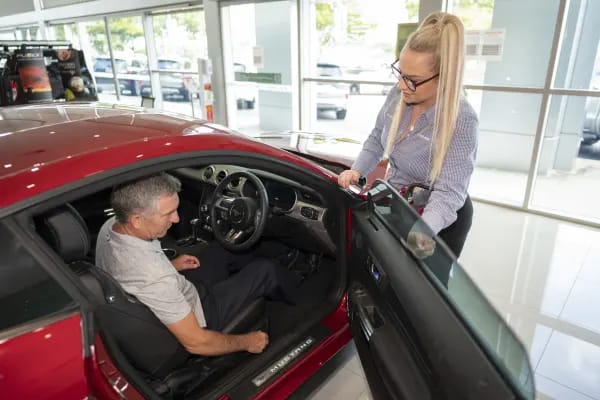
Review: 2017 Kia Stinger
Posted in Vehicle Reviews
Review: 2017 Kia Stinger
Pros
- Clean design inside and out
- Excellent handling
- Powerful V6
Cons
- Rear window not great for parking
- Overzealous alerts systems
A rear-wheel drive sports tourer from Kia? Believe it.
We took the game-changing South Korean out for a drive.
Driving a Kia 15-20 years ago meant that your desire for a new car was only undercut by your budget. The company faced a reputation problem – dogged by an image of cheap, throwaway vehicles.
Kia recognised this, making big hires behind-the-scenes over recent years including former VW Group design guru Peter Schreyer to restyle their range from dowdy to stylish and, more recently, Albert Biermann – ex-head of development at BMW’s M performance car division – to head up engineering as they step out from everyday transport into cars that you want to take out for a drive.
The Stinger is the culmination of the globalisation of the Kia boardroom – a car that could lift the brand from an also-ran into the mainstream.
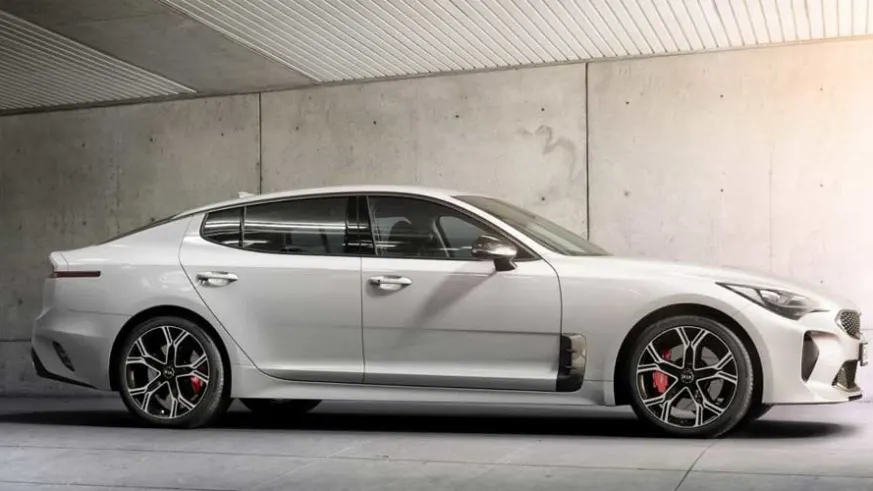
INITIAL IMPRESSION
Look at any of the other cars in the Kia showroom – then look at a Stinger. Better yet, look at a BMW 3-series (and the accompanying price tag and option list) then look at the Stinger and its $49,990 + on-roads entry price.
In fact, dollars to doughnuts, cover up the badges and you wouldn’t look out of place amongst European coupes in the swankier parts of the city.
Inside the Stinger GT, it’s an evolution of the Optima GT that previously sat at the top-of-the-tree in the Kia stable. Red leather seats pop behind a sports-focused small, flat-bottomed steering wheel and accompanied by aviation-inspired vents, coupled with a new, vertical slab-style screen that houses your multimedia and navigation.
It all adds up to a pretty impressive interior that avoids the problem that plagues a lot of ‘upmarket’ cars from mainstream brands: that is, they try and cram as much ‘stuff’ into the car as possible – confusing quantity and quality.
As it stands, the Stinger makes a strong impression right out of the gate by its classical approach to design, while incorporating the practicality and reliability that Kia has worked hard to build over the last 20 years.
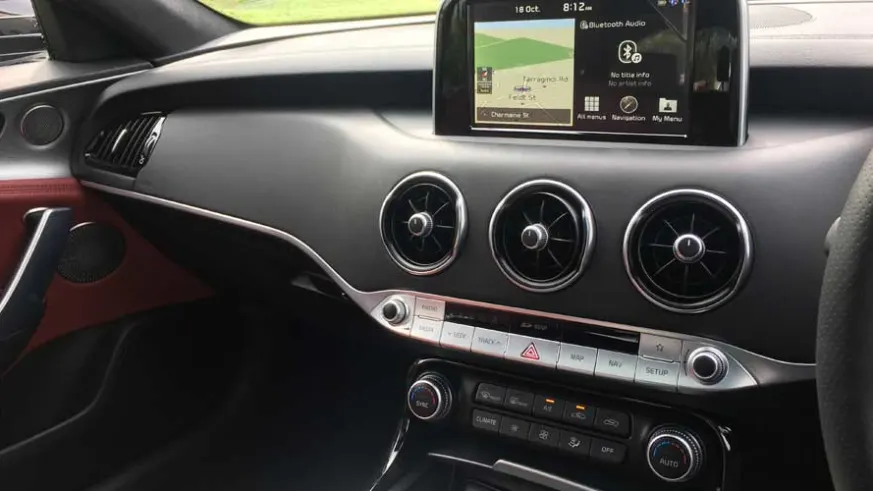
DRIVEABILITY
Much has been made of the fact that it replaces Holden and Ford as the flag-bearer for rear-driven sedans – tentatively suggesting that buyers will cash in their Commodores and Falcons when time comes to replace them.
While it doesn’t have the same roar and wild, unrestrained feeling of the V8s that defined the Australian motoring scene for decades, the twin-turbo V6 is fun in a way that will surprise you (and no doubt the police officer writing you a ticket) as you zip down a straight or push the back out on a corner with the Stinger’s well-executed handling. Overseas models can be optioned with all-wheel drive, which I can’t see adding too much more to the driving experience of the Stinger – maybe to give you added assurance on super slick or icy roads, but Australians should do well with just the back wheels to drive the car.
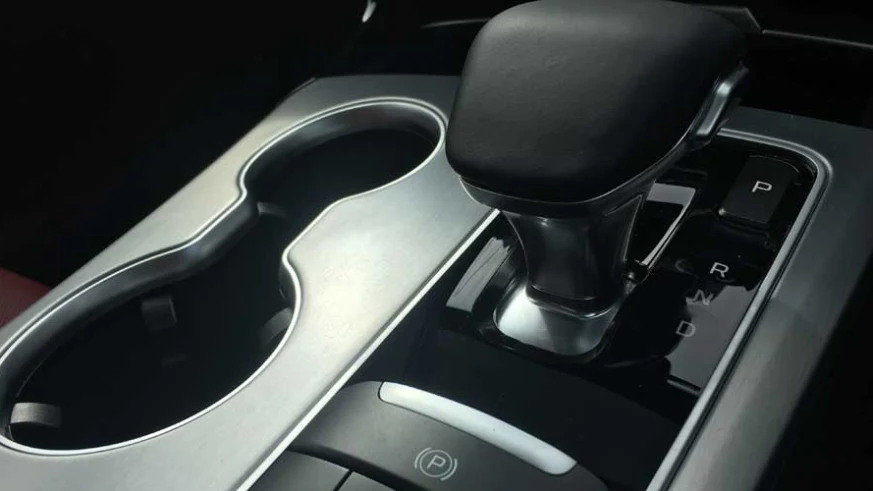
The eight-speed auto is incredibly smooth (even if the gearshift is infuriatingly laid out to switch up for neutral and reverse, down for drive, pushing a button for park and then pulling another button for the electronic handbrake – ugh!) and changes up and down almost imperceptibly.
Even a drive at suburban speeds feels exciting in the Kia – the car feels agile, you would certainly forget that you could load child seats and have room for an average weekly shop in the boot while hovering around 50-60kph. Take the speedo into triple digits and the car firms up (especially in Sport mode), standing up straight as a sports tourer, weighting the steering with the just the right balance to keep you dead on line.
In Comfort mode, there isn’t an appreciable ‘softening’ of the suspension from in the driver’s seat – which can be good or bad depending on what you want out of your Stinger.
It doesn’t suddenly make the Stinger suddenly glide over bumps in the road – but it also starts from a fairly neutral place to begin with: the suspension certainly isn’t as hard as a model that’s blindly geared towards performance (like a Ford Focus RS) but it’s not as plush as your average four-door sedan (but it will probably outgun them at the lights.)
All this is to stay that the new Kia is good. Very good, in fact.
LIVEABILITY
Cars are sold largely on image first and practicality second. Urban SUVs currently bask in popularity after forging a link between go-anywhere versatility and spacious practicality – making them the go to vehicle for families especially. 4WD dual cab utes enjoy are enjoying a similar status as a double-duty work car/family vehicle.
The sedan, as a concept, has languished – unloved by car marketing departments for their unsexy proportions and dependability, and their practical (if not headline-grabbing) spaciousness and liveability.
Coupes are the new game – sleek hatch/sedan hybrids to reinvigorate cars for families who don’t want or need a big wagon to do the school run or the commute to the office. Ford did it with the Mondeo, Holden is doing it with the new Commodore and so Kia follows with the Stinger.
In terms of space, the Stinger is up there with large sedans: put two adults in the back seat (three if the ride isn’t too long) and no one will be complaining (unless they’re incredibly tall) – similarly, boot space is not diminished to nothing with the tapering of the rear roofline but can comfortably fit school bags and extracurricular gear, a fortnight’s shopping or the golf bag on the weekend.
Visibility out of the front seat is great – even the lengthy bonnet is easy to estimate into spaces without the dreaded thud of the bumper nudging into the wall or tyre guard and the Stinger GT’s panoramic sunroof opens up the cabin ambience without substantially intruding on headroom.
Rear visibility when parking isn’t a strong point in the Stinger, unfortunately, with the rear window largely decorative. Thank the engineers at Kia for including not just the standard reverse camera, but also a 360-degree around view camera that is a lifesaver when pulling into a space.
On the road, the one complaint you could have is with the suite of alarms sounded by the safety features included in the Stinger. The adaptive cruise control at its most sensitive is ultra conservative in the amount of space it should leave between you and the car in front, while the lane departure warning is very eager to chime without an appreciation of other factors (such as if you have to cross lanes to get around street-parked cars.)
The lane-keeping assist, which gives the steering tiny corrections to keep you in your lane, is neat if not a little disconcerting when you first notice it while the forward collision warning can freak out even if the obstruction in front of the car is glancing at best, and easily avoided by a new driver.While all of these features are designed to keep your Stinger from ending up crashed and stranded on the side of the road, there’s a fine line between protective and over-protective and while most drivers appreciate warnings, I don’t imagine they want to be babied – so when you buy your Stinger make sure you go through your car’s settings thoroughly with your salesperson at the dealership so you can dial the sensitivity up or down depending on who’s driving.
The driving modes are a happier story from the brochure, with noticeable changes available as you switch through the modes. Comfort loosens up the steering for around town, Sport firms it up for the open road while Custom and Smart modes promise adaptability that will no doubt work even better as the Stinger acclimates to your personal driving style.
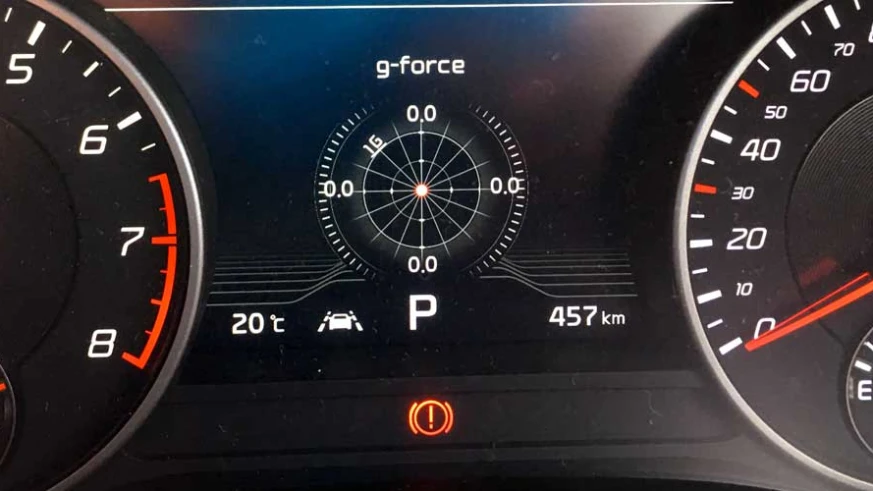
The multimedia system is similar to what Kia has had in recent years – although the screens have started to pile up, entering through multiple screens for settings, and it’s not as easy as it once was to just jump into the ecosystem. It’s not the most difficult thing in the world to navigate, and Android Auto/Apple CarPlay is thrown in with the deal, but if you’re coming out of a car whose most complicated multimedia feature is its CD stacker you might need a refresher course with the Stinger’s user manual.
The default screen that sits in between the dials is a g-force measurement, which is largely gimmicky for everyday use – I expect as the aftermarket tuning community builds up around the Stinger this will probably become more useful.
The feature that everyday commuters will find more use out of is the head-up display with speed and lane/surrounding warnings (blind spot, forward collision.) This allows you to keep an eye on the road, while simultaneously letting you know of your surrounds before you even turn your neck to check the mirrors – infinitely more helpful on the open road.
All-in-all, the Stinger is handsomely equipped to compliment it’s pride of place as the flagship in the Kia range, especially considering you’ll get change from $60,000 (before on-roads) for a top-of-the-line GT model.
COST
Prices for the four-cylinder Stinger start at $49,990 rising to $59,990 for the twin-turbo 3.3L six-cylinder GT. The S entry model of the four cylinder sandwiches the Si mid-spec and GT-Line Stinger (with the styling inside and out of the GT) – same goes for the six-cylinder (which is obviously topped with the honest and true GT model.) All pricing is before on-road costs, such as registration, stamp duty and dealer delivery.
The Stinger comes in a good swathe of colour swatches standard (Sunset Yellow is a personal fave) while Deep Chroma Blue, Aurora Black and Snow White Pearl are available at additional cost. (Aurora Black and Snow White Pearl are also only available on GT-Line and GT models.)
Kia’s class-leading 7 year warranty covers capped price servicing with complimentary roadside assist – adding onto an already impressive package. Unlike the unlimited kilometres offered to other models though, the Stinger only receives coverage up to a limit of 105,000km in the first seven years (70,000km for petrol turbo models.)
CONCLUSION
Once a maker of budget cars that could best be described as ‘average’, Kia has put a lot of effort in to transform themselves into a real competitor to far more established brands – lifting themselves from the depths of brand snobbery to be on-par, if not better, than a lot of carmakers with longer histories in Australia. The proof is in the pudding: the Stinger won 'Best Large Car Under $70,000' in the Australia’s Best Cars Awards, judged by Australia’s state automotive bodies. In praise of the Stinger, the judges offered: “While so many Australians continue to flock to SUVs without even considering the other options, the Kia Stinger offers almost SUV-like practicality but with the handling of a low-slung sportscar … In the large car category, and indeed the new car market as a whole, the Stinger has been a breath of fresh air.”
The Stinger is a halo model that shouldn’t feel as surprising as it does – there is still the shock that the same people who crafted the paragon of family transport in the Kia Carnival were able to come up with something as genuinely fun, sporty and capable of family transport as the Stinger.
To test drive the Stinger for yourself, see the team at Motorama Kia – but if you want to put in your order, be quick to get on the top of the list to get stock.


